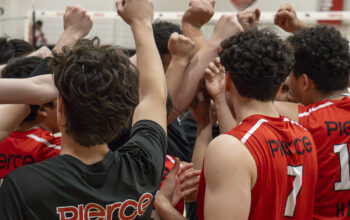After 20 years of denial, the NFL has finally acknowledged that concussions and brain diseases such as C.T.E. (Chronic Traumatic Encephalopathy) are linked.
Jeff Miller, the NFL’s senior vice president for healthy and safety, admitted that there is a link between football and brain disorders during a roundtable discussion on concussions at an assembly of the U.S. House of Representatives in March, 2016.
With concussions now an epidemic, athletic staff at Pierce have continued to maintain proper player safety and concussion protocol.
“The trainers [at Pierce] have a concussion protocol that they give every athlete. All the way from women’s volleyball to football,” said Pierce athletic director Bob Lofrano.
According to NCAA.org, in a survey taken by approximately 20,000 collegiate athletes, 19.4 percent of men and 12.1 percent of women reported experiencing a concussion.
“We do a pre-screening with our athletes every pre-season. It doesn’t matter what sport,” athletic trainer Robert Horowitz said. “Every sport gets acknowledged and athletes cannot be cleared to play unless they’ve completed a concussion screening test.”
When a student is diagnosed with a concussion, they are asked to sit out for at least a week, depending on the severity of it.
Lawyers of NFL players that had brain injuries in the past were quick to respond to the league.
“There have been lawsuits against the NFL by former football players who were diagnosed with C.T.E.,” Bob Lofrano, athletic director at Pierce College said. “If this would have been acknowledged sooner it would have saved some lives.”
Most leagues, such as high school football all the way up to college, both take their practices and training from the NFL.
“We do a pre-screening with our athletes every pre-season. It doesn’t matter what sport,” Horowitz said. “Every sport gets acknowledged and athletes cannot be cleared to play unless they’ve completed a concussion screening test.”
When a student is diagnosed with a concussion, they are asked to sit out for at least a week, depending on the severity of it.
To conduct safer practices in football, Horowitz said, they can limit full-contact days to once or twice a week.
Players are required to wear a set of equipment to try and prevent injuries.
“It could be equipment causing the [head] injuries,” Lenny Ramirez, athletic trainer at Pierce College, said. “The person that issues the equipment, it’s his job to make sure that the helmet is safe and has proper padding.”
Star athletes in the NFL and NBA including: Lebron James, Brett Favre, Kurt Warner and Adrian Peterson have said they would not let their child play football.
“It’s hard to prevent a concussion because it’s a blow to the head,” Lofrano said. “Coaches will let players back in the game if they’re unaware of it this day and age.”
Concussions have also been linked to depression. In 2012, when All-Pro linebacker Junior Seau committed suicide it was found that Seau suffered from brain disease after 20 years of hits to the head.
“Once the equipment man gives the helmet to the player, it then becomes the player’s responsibility to check their equipment,” Ramirez said.
According to neurologyreviews.com, 40 percent of retired players who have a history of concussions have said they have mild to moderate symptoms of depression.
The NFL’s acknowledgment towards the direct link between football and brain disorders may have brought them many issues, but may also benefit the league as well.
“As time has been going on there’s more and more awareness, there’s more and more data, and there’s more and more education. The NFL is slowly evolving,” Ramirez said.



